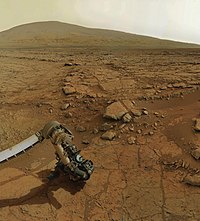Habitability of K-type main-sequence star systems
 |
| This article is one of a series on: |
| Life in the universe |
|---|
| Outline |
| Planetary habitability in the Solar System |
| Life outside the Solar System |
| Habitability of... |
K-type main-sequence stars, also known as orange dwarfs, may be candidates for supporting extraterrestrial life. These stars are known as "Goldilocks stars" as they emit enough radiation in the non-UV ray spectrum[1] to provide a temperature that allows liquid water to exist on the surface of a planet; they also remain stable in the main sequence longer than the Sun by burning their hydrogen slower,[2] allowing more time for life to form on a planet around a K-type main-sequence star.[3] The planet's habitable zone, ranging from 0.1–0.4 to 0.3–1.3 astronomical units (AU),[4][better source needed] depending on the size of the star, is often far enough from the star so as not to be tidally locked to the star, and to have a sufficiently low solar flare activity not to be lethal to life. In comparison, red dwarf stars have too much solar activity and quickly tidally lock the planets in their habitable zones, making them less suitable for life. The odds of complex life arising may be better on planets around K-type main-sequence stars than around Sun-like stars, given the suitable temperature and extra time available for it to evolve.[5] Some planets around K-type main-sequence stars are potential candidates for extraterrestrial life.[2]
Habitable zone
[edit]A K-type star's habitable zone approximately ranges between 0.1–0.4 to 0.3–1.3 AU from the star. Here, exoplanets will receive only a relatively small amount of ultraviolet radiation, especially so towards the outer edge. This is favorable to support life, as it means that there is enough radiated energy to allow liquid water to exist on the surface, but not so much, especially ionizing radiation, as to destroy life.[4]
The habitable zone is also very stable, lasting for most of the K-type main-sequence star's main sequence phase and with little instability of luminosity during that phase.[6]
Radiation hazard
[edit]
Despite K-stars' lower total UV output, in order for their planets to have habitable temperatures, they must orbit much nearer to their K-star hosts, offsetting or reversing any advantage of a lower total UV output. There is also growing evidence that K-type dwarf stars emit dangerously high levels of X-rays and far ultraviolet (FUV) radiation for considerably longer into their early main sequence phase than do either heavier G-type stars or lighter early M-type dwarf stars.[7] This prolonged radiation saturation period may sterilise, destroy the atmospheres of, or at least delay the emergence of life for Earth-like planets orbiting inside the habitable zones around K-type dwarf stars.[7][8]
Potentially habitable planets
[edit]The super-Earth HD 40307 g around the K2.5V star HD 40307 orbits in the circumstellar habitable zone (CHZ), although it has a reasonably elliptical orbit (e=0.22). There may be many more, and the Kepler space telescope (now retired) was one of the main sources of information of these exoplanets.[9] Kepler-62 and Kepler-442 are examples of discoveries by Kepler of systems consisting of a K-type dwarf with potentially habitable planets orbiting it.
HD 85512 b was originally thought to be a super-Earth with habitability potential orbiting a K-type main-sequence star,[10][11] but it is now considered to be a false positive detection,[12] an artifact caused by stellar rotation.[13]
See also
[edit]- Astrobiology
- Circumstellar habitable zone
- Habitability of F-type main-sequence star systems
- Habitability of neutron star systems
- Habitability of red dwarf systems
- Habitability of yellow dwarf systems
- Planetary habitability
References
[edit]- ^ Grossman, Lisa. "Sun may not be a 'Goldilocks' star". Science News. Archived from the original on 27 December 2021. Retrieved 16 April 2014.
- ^ a b Shiga, David. "Orange stars are just right for life". New Scientist. Archived from the original on 13 January 2015. Retrieved 16 April 2014.
- ^ Vieru, Tudor. "Life Could Easily Develop Around Orange Dwarfs". Softpedia. Archived from the original on 16 April 2014. Retrieved 16 April 2014.
- ^ a b Merchant, David (18 June 2009). "Orange Dwarf Stars and Life – Common?". Archived from the original on 16 April 2014. Retrieved 16 April 2014.
- ^ Loeb, Abraham (2017). "Reduced biodiversity of life around Proxima Centauri and TRAPPIST-1". The Astrophysical Journal Letters. 846 (L21): L21. arXiv:1707.07007. Bibcode:2017ApJ...846L..21L. doi:10.3847/2041-8213/aa8860. S2CID 118880329.
- ^ "Kepler's Hunt for Earths Shows Progress at Space Conference" Hadhazy, Adam March 9, 2010 12:00 AM
- ^ a b Richey-Yowell, Tyler; Shkolnik, Evgenya L.; Loyd, R.O. Parke; et al. (2022-04-26). "HAZMAT. VIII. A spectroscopic analysis of the ultraviolet evolution of K stars: Additional evidence for K dwarf rotational stalling in the first gigayear". The Astrophysical Journal. 929 (2). American Astronomical Society: 169. arXiv:2203.15237. Bibcode:2022ApJ...929..169R. doi:10.3847/1538-4357/ac5f48.
- ^ Toubet, Georgina (22 April 2022). "What UV radiation from the 'Goldilocks' stars could really mean". slashgear.com. Archived from the original on 2022-05-20. Retrieved 2022-05-14.
- ^ Adam Hadhazy Kepler's Hunt for Earths Shows Progress at Space Conference Archived 2010-08-31 at the Wayback Machine, Popular Mechanics, March 9, 2010
- ^ Kaltenegger, L; S. Udry; F. Pepe (2011). "A Habitable Planet around HD 85512?". arXiv:1108.3561v1 [astro-ph.EP].
- ^ Pepe, F.; Lovis, C.; Ségransan, D.; Benz, W.; Bouchy, F.; Dumusque, X.; et al. (3 October 2011). "The HARPS search for Earth-like planets in the habitable zone". Astronomy & Astrophysics. 534: A58. arXiv:1108.3447. Bibcode:2011A&A...534A..58P. doi:10.1051/0004-6361/201117055. S2CID 15088852.
- ^ "HD 85512 Overview". NASA Exoplanet Archive. Retrieved August 12, 2024.
- ^ Laliotis, Katherine; Burt, Jennifer A.; Mamajek, Eric E.; et al. (22 February 2023). "Doppler Constraints on Planetary Companions to Nearby Sun-like Stars: An Archival Radial Velocity Survey of Southern Targets for Proposed NASA Direct Imaging Missions". The Astronomical Journal. 165 (4): 176. arXiv:2302.10310. Bibcode:2023AJ....165..176L. doi:10.3847/1538-3881/acc067.
